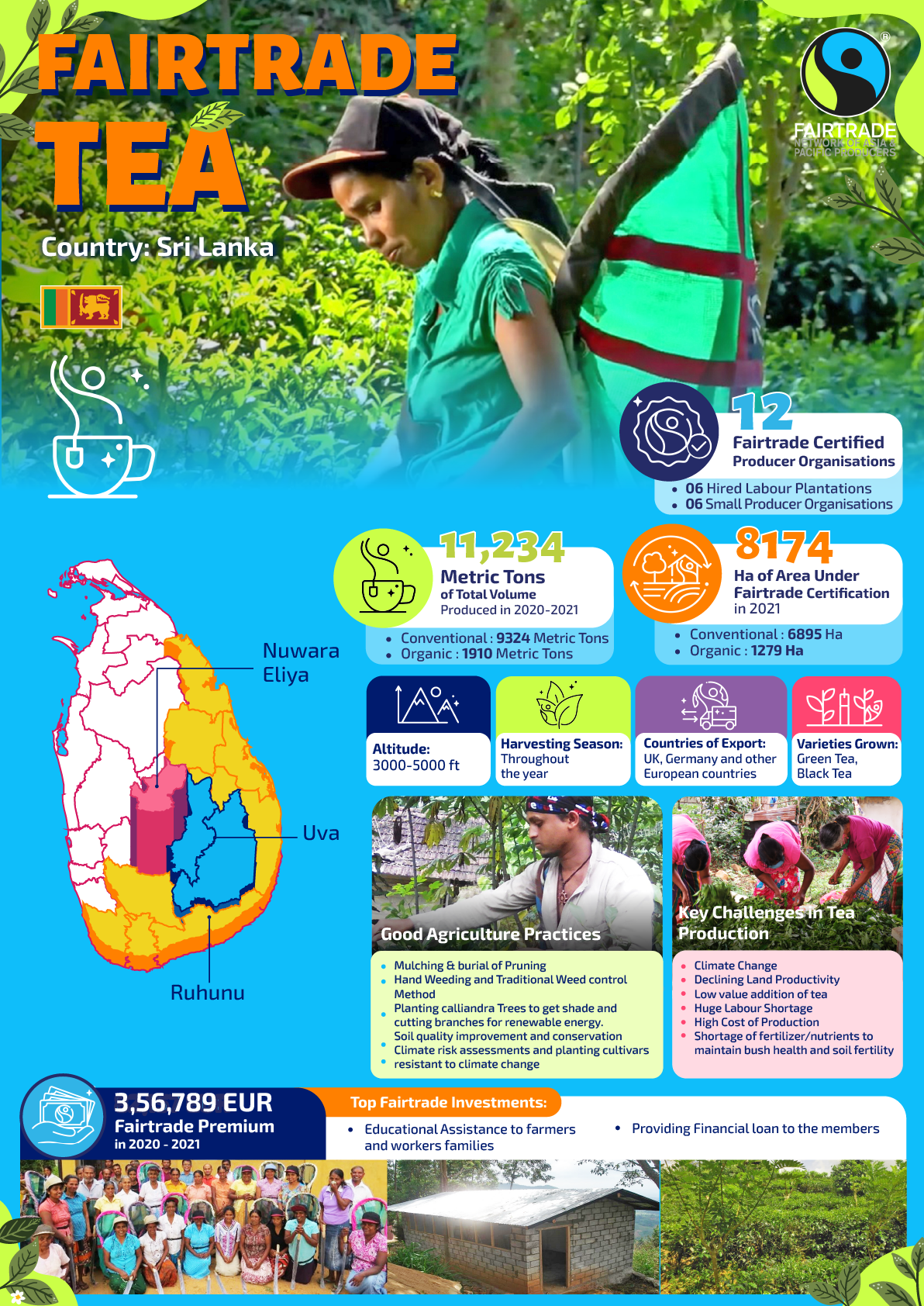Fairtrade NAPP currently has 65 Fairtrade certified Producer Organisations across 06 countries ( India, Sri Lanka, Bangladesh, China, Vietnam & Thailand) in Asia and Pacific region. The products are mainly exported to UK, US and EU.
- 21 Hired Labour Plantation Multiestates
- 13 Hired Labour Single Plantation
- 31 Small Producer Organisations
The maximum of the Fairtrade Premium Amount are invested utilised for social investments of the farmers, workers, their families and communities such as education, health and safety, housing and sanitation etc. The other investments include business and organisational development ( training and capacity building of Producer Organization board and committees) , improving productivity ( provision of agricultural tools and inputs, farmers training in agricultural or business practices, Implementation of on-farm best practices, facilities and infrastructure within the organization ), financial benefits (Credit and financial services for workers and their families, payments to members, workers and their families), environmental investments ( environmental services for communities) and Premium Committee and other related committee running costs.

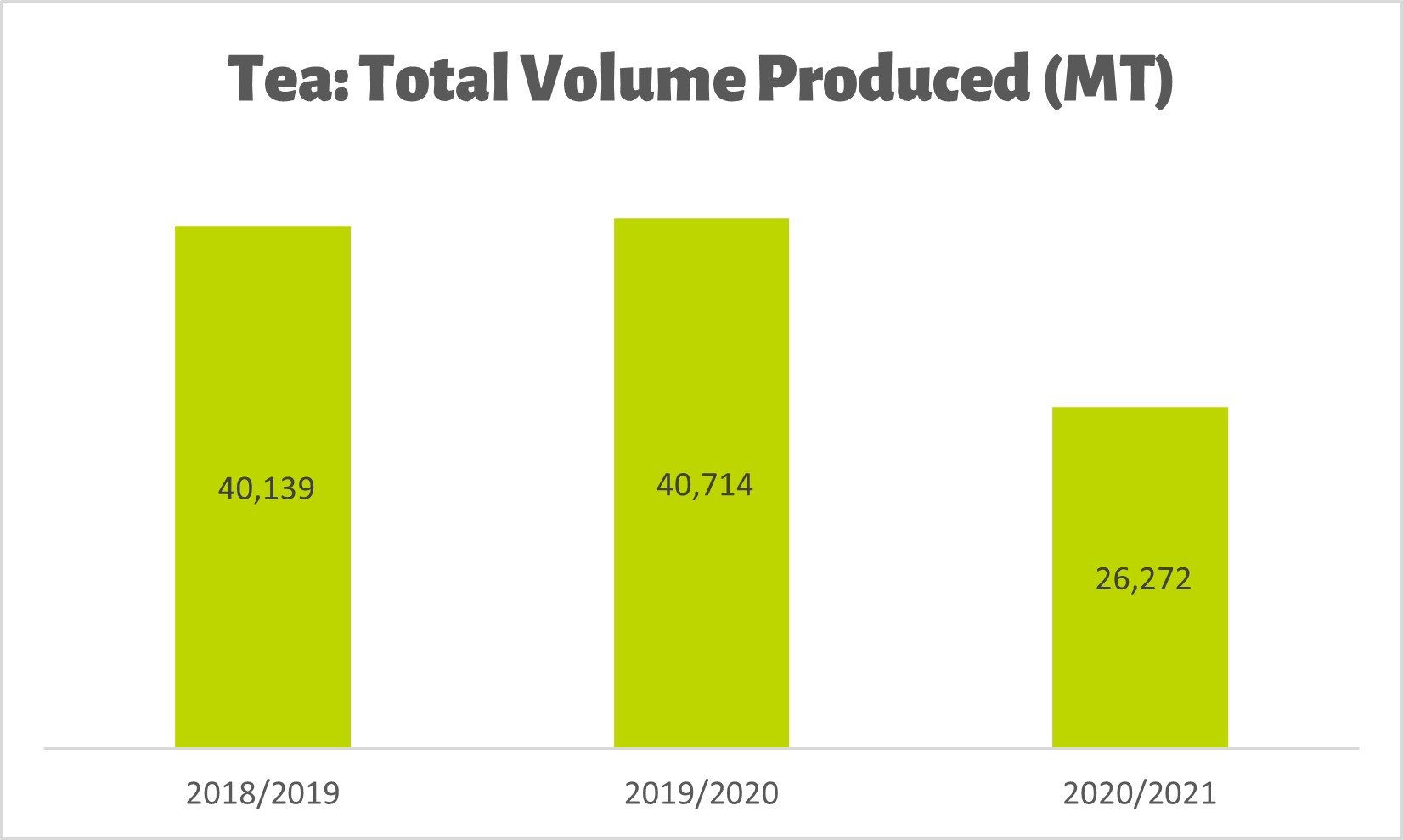
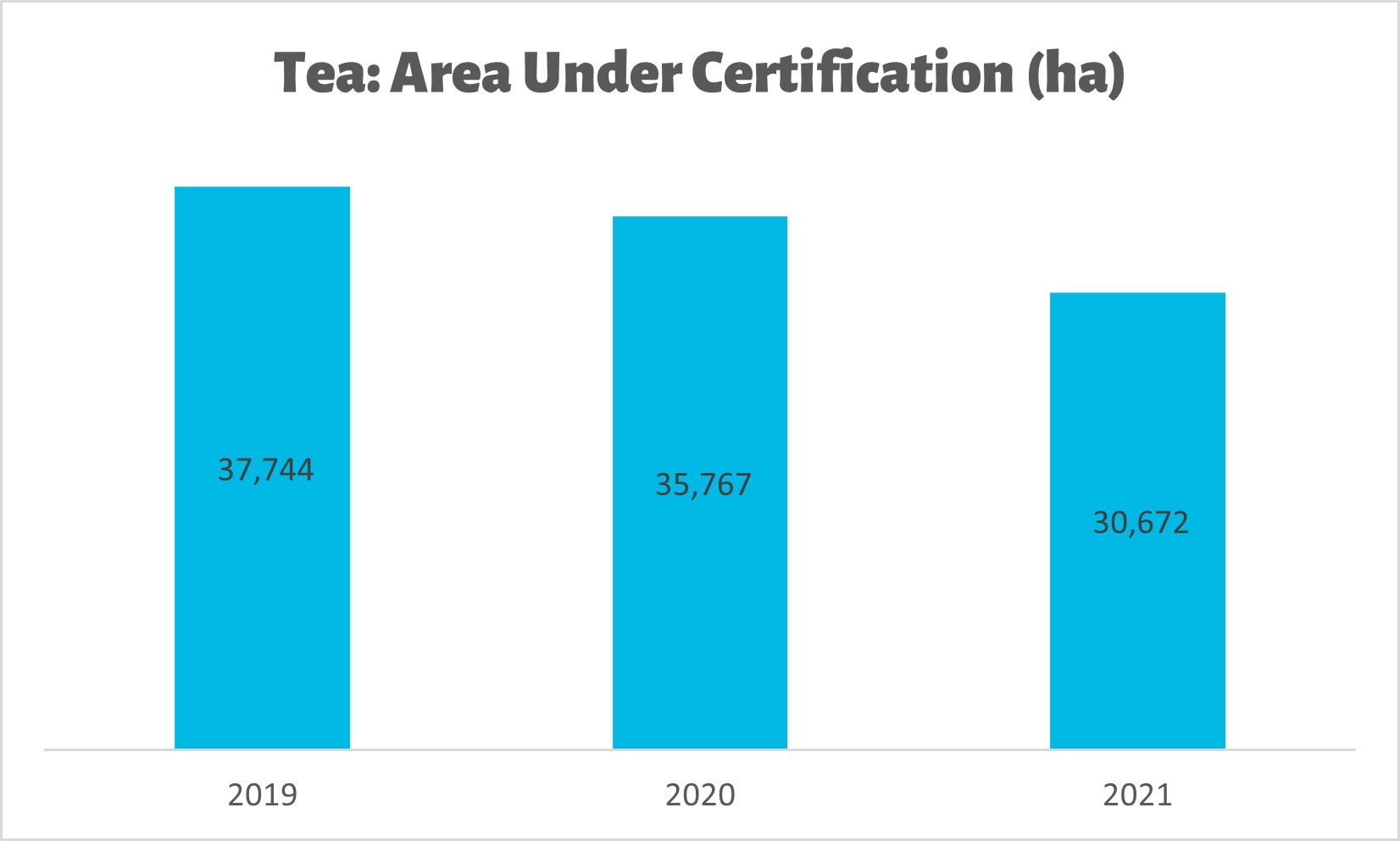
Background of Tea in India
Steeped in ancient traditions, lush landscapes, and rolling hills, India’s tea history emerges as a captivating journey that has enticed tea enthusiasts worldwide. The tale begins in the early 19th century when British adventurers embarked on an exploration that led them to the discovery of tea plants nestled within the dense forests of Assam. Recognizing the immense untapped potential, they laid the foundation for what would ultimately blossom into India’s thriving tea industry. With the introduction of Camellia sinensis, the tea plant, the fertile terrains of Assam became the birthplace of robust and malty Assam tea, renowned for its invigorating flavour and deep amber hues.
ASSAM
A name meaning “one without equal,” Assam truly lives up to its reputation regarding its teas. It is said that one’s awakening isn’t complete until they have savoured the essence of Assam tea. This strong tea is cultivated on the undulating plains alongside the majestic Brahmaputra River, weaving its way through valleys and hills. Crafted by the region’s rich loamy soil, unique climate and generous rainfall, Assam tea is celebrated for its smooth and malty flavour. Included among the important biodiversity hotspot of the world, Assam is also a refuge for endangered species like the One-horned Rhino, Red-headed Vulture and the Hoolock Gibbon and of course, mind-boggling diversity. From the facilities such as the world’s oldest and largest research station of its kind, the iconic Tocklai Experimental Station, the government engages in clonal propagation and constant research to ensure the production of high-quality tea with its signature full-bodied liquor. Assam boasts the manufacturing of both Orthodox and CTC (Crush/Tear/Curl) varieties of tea, with Assam Orthodox Tea holding the esteemed status of a registered Geographical Indication (GI).
Assam tea is produced in two distinct regions: the Assam Valley, situated north and south of the Brahmaputra River, and Cachar. At a staggering 687.93 million kilograms from the combined production of these regions, the State contributed significantly to the overall tea production in India (1365.23 million kilograms) during the same period. Assam tea enjoys an average rainfall of 250 to 380 centimetres as it is grown at elevations ranging from 45 to 60 meters above sea level
Embracing a rich, deep-amber hue, Assam tea is renowned for its full-bodied cup, creating the perfect blend of briskness, strength, and malty character to kickstart one’s day. The distinctive second-flush orthodox Assam teas are highly regarded for their rich taste and vibrant liquors, earning them an esteemed place among the finest teas in the world.
Over time, the legacy of Indian tea expanded to the misty hills of Darjeeling, where a combination of altitude, climate, and fertile soil created the ideal conditions for cultivating exquisite teas. Revered as the “Champagne of Teas,” Darjeeling tea captivates with its delicate flavours, floral aroma, and distinct muscatel notes. Each sip tells a tale of artistry and dedication, as the harvested leaves undergo meticulous processing to preserve the essence of the region.
DARJEELING
Darjeeling tea unfolds its story in the Eastern Himalayas, nestled in the northern part of the Indian state of West Bengal. Cultivated at elevations ranging from 600 to 2000 meters above sea level, tea found its roots in the Darjeeling region during the early 1800s. Exotic and enigmatic, Darjeeling tea owes its unique character to the combination of the local climate, soil conditions, altitude, and meticulous processing. In 2022, a total of 6.64 million kilograms of Darjeeling tea were produced across 17,500 hectares of land, scattered across 87 renowned tea gardens.
It is a sought-after luxury brand as connoisseurs worldwide relish the taste of Darjeeling tea due to its distinct aroma and elusive fragrance that enchants the senses. It holds the treasured status of India’s cultural heritage as a Geographical Indication, authenticated by a unique logo known as the Darjeeling logo, registered under The Trade Marks Act 1999. When brewed, Darjeeling tea exhibits a colour ranging from pale lemon to rich amber, and the brew is known for its varying degrees of visual brightness, depth, and body. The flavour that emanates from the brew is a complex and pleasing combination, with attributes of aroma, bouquet, and point. The organoleptic characteristics of Darjeeling tea are often described as mellow, smooth, round, delicate, mature, sweet, lively, dry, and brisk.
Darjeeling tea offers more than just a delightful taste; it possesses the power to flow through your veins and help you unwind. Its essence encapsulates the rhythm of seasons, from spring to summer and autumn, unveiling the dance of nature in the tea gardens. The fragrance that wafts from the cup is purer and more unique than any other, embodying the mist, green leaves, and blue skies of Darjeeling. Take a deep breath and feel it stir your soul. Drinking Darjeeling tea is a way to free your mind and absorb the warmth of the sun.
Today, tea cultivation has extended to almost all the North Eastern States of India, including Arunachal Pradesh, Meghalaya, Mizoram, Manipur, Nagaland, Tripura, and Sikkim, in addition to certain parts of South India. However, the most recognized teas from the region remain Assam Tea and Darjeeling Tea. Since 1992, Fairtrade has certified Darjeeling Tea, while Assam Tea earned its certification in 2005.
Today, tea stands as a source of regional pride, with its demand reaching far and wide across the globe. Nurtured by unique geography and meticulous craftsmanship, these teas continue to enchant tea connoisseurs worldwide, celebrating India’s legacy as the land of exceptional teas.
Southern India
The story of South India’s tea heritage is as aromatic, delightful and captivating as the revitalizing brews it has bestowed upon the world. The region’s affection for tea traces back to centuries amidst ancient traditions and beautiful culture. From the mist-laden valleys of Assam to the undulating hills of Darjeeling and the picturesque hills of the Niligiri Mountains, a mesmerizing tale of an enchanting story is brewed in each cup!
Today, the southern region of India, encompassing states like Tamil Nadu, Kerala, and Karnataka, has approximately 17% contribution to total national tea production. Among these, the Nilgiris region of Tamil Nadu soars high due to its captivating demand for one of the finest teas, the renowned Nilgiri tea. Numerous Fairtrade-certified tea estates flourish in the region in addition to some in the Coimbatore district of Tamil Nadu and the Idukki and Palakkad districts of Kerala.
The history of Nilgiri tea dates back to 1835 when the initial Camellia sinensis (Tea) plants were brought to the Nilgiri region by the British government to challenge the Chinese supremacy in the worldwide tea trade. The British, in their pursuit of an alternative to Chinese tea and the establishment of tea cultivation in their hill stations, sent tea seeds to the Nilgiris and other locations in southern India. As a result, many of the tea estates and architectural remnants in the region bear the mark of British colonialism, infusing the tea-growing landscape with a captivating fusion of old-world allure.
Today, tea stands as a testament to regional pride, its allure transcending borders and captivating numerous enthusiasts worldwide. Nurtured by the distinctive geography and artisanal craftsmanship, India’s legacy as a haven for extraordinary tea is celebrated as it continues to captivate discerning palates across the world.
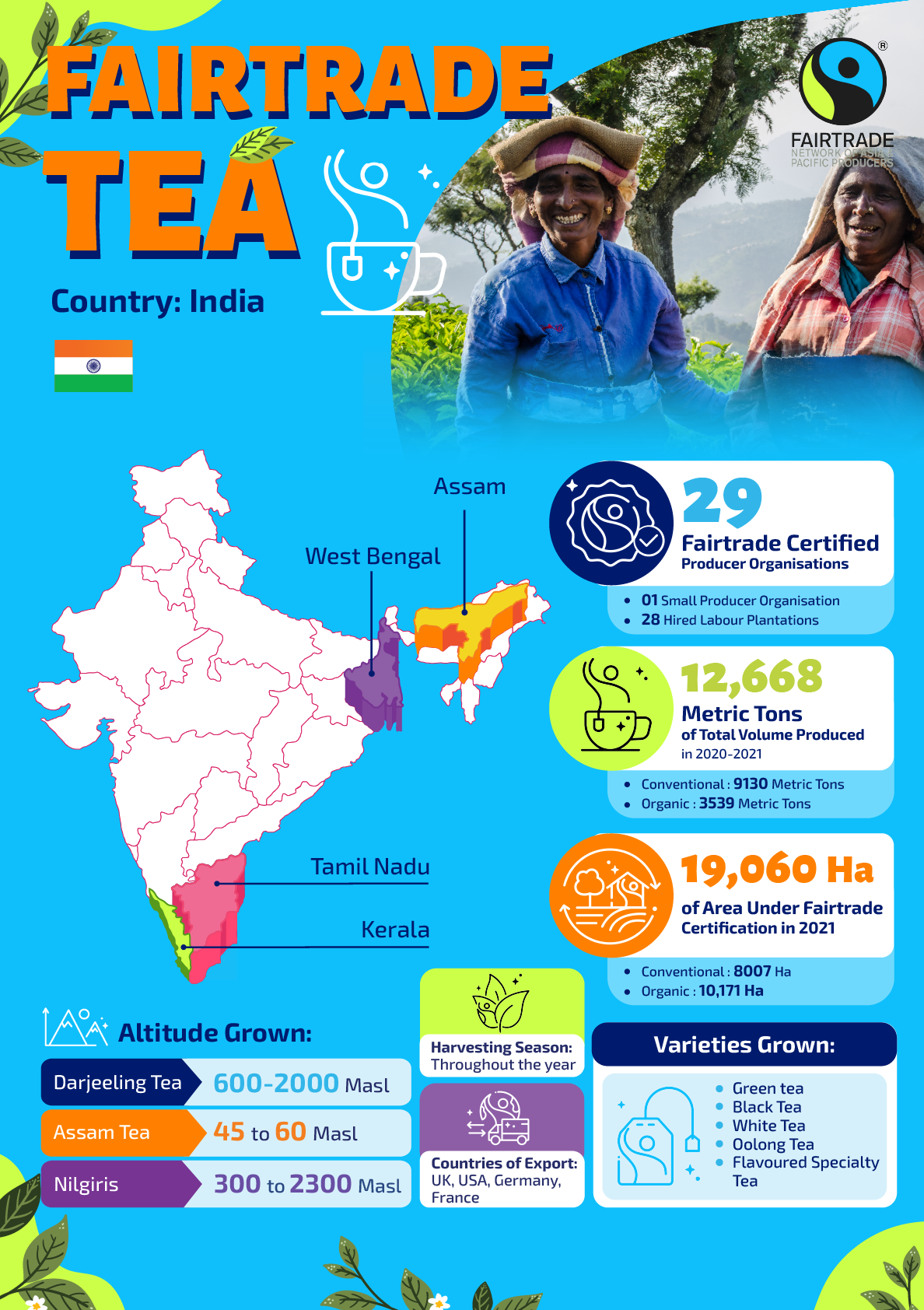
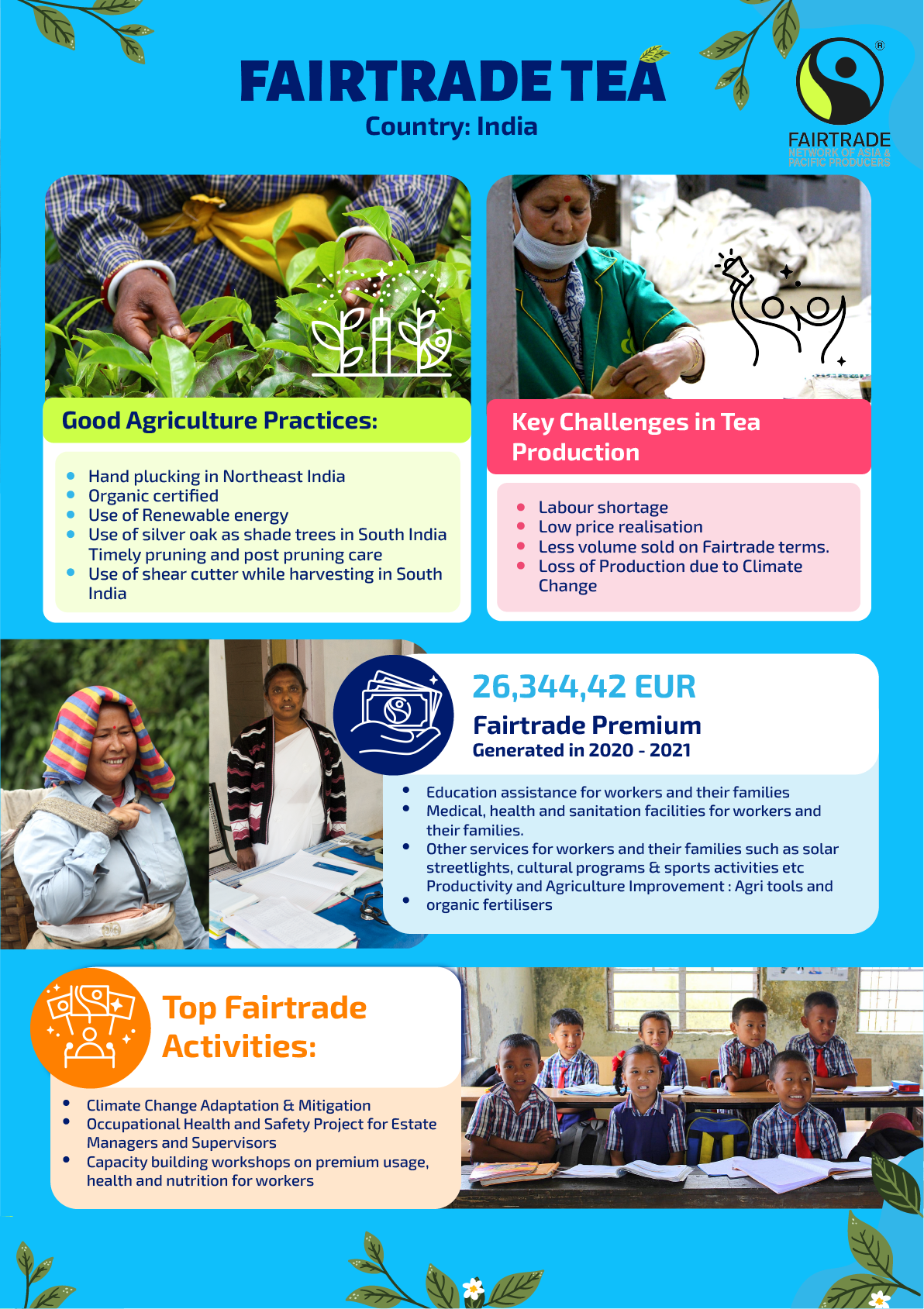
VIETNAM
Background of Tea in Vietnam
The chronicles of tea cultivation are revered through strong traditions and national pride in Vietnam. The Vietnamese tea heritage is today celebrated for its exceptional tea while it emerged itself as a significant player in the global tea market. Nestled in the northern and northwest regions, such as Thai Nguyen, Lao Chau, and Son La, as well as the beautiful central highlands of Lam Dong and Bao Loc, Vietnam’s tea cultivation flourishes. Blessed with ideal climatic conditions and diverse landscapes, these regions gift Vietnamese teas with their distinct flavours and enticing aromas. This takes them to distinguished destinations across the globe where they are valued for quality and affordability.
With noteworthy tea varieties named after producing regions such as “Sencha,” “Moc Chau,” and “Suoi Giang”, the Vietnamese tea producers showcase their artistry and skills possessed through generations. Crafted meticulously using traditional methods such as pan-firing and steaming, the vibrant green tea varieties are renowned for their invigorating and verdant profiles. Vietnam also boasts a repertoire of black, oolong, and scented tea. Commencing around March-April, tea production in Vietnam adheres to seasonal rhythms with harvests varying across regions and tea types. This ensures a continuous supply of fresh and flavorful teas, allowing enthusiasts to relish the essence of each season.
As of 2021-22, Vietnam’s tea exports continue to flourish, solidifying its standing as one of the world’s foremost tea exporters. A testament to its influential presence in the global tea landscape, an impressive amount of 1.09 million metric tons of tea was exported to countries such as Russia, China, and Iraq among others. Despite the challenging backdrop of the COVID-19 pandemic, Vietnam’s tea exports have displayed remarkable resilience which is a testament to the industry’s adaptability and unwavering spirit.
In recent years, Vietnam’s tea industry has embraced sustainability and quality enhancement as guiding principles. Organic tea cultivation and sustainable farming practices have gained momentum, ensuring the preservation of tea production for generations to come in addition to safeguarding the precious environment. Through Fairtrade initiatives and certification programs, endeavours are underway to secure fair prices and improved livelihoods for tea farmers.
Vietnam’s tea production paints a vibrant canvas, adorned with a diverse array of tea varieties, with a particular reverence for green tea. The idyllic tea gardens of northern and central Vietnam, graced by nature’s benevolence, breathe life into each leaf. With its expanding tea exports and unwavering commitment to sustainability, Vietnam’s tea industry has garnered global recognition and admiration. As tea connoisseurs traverse the paths of Vietnamese tea while immersing themselves in the rich flavours and cultural heritage, the future of tea production in Vietnam glimmers with boundless promise and endless possibilities.
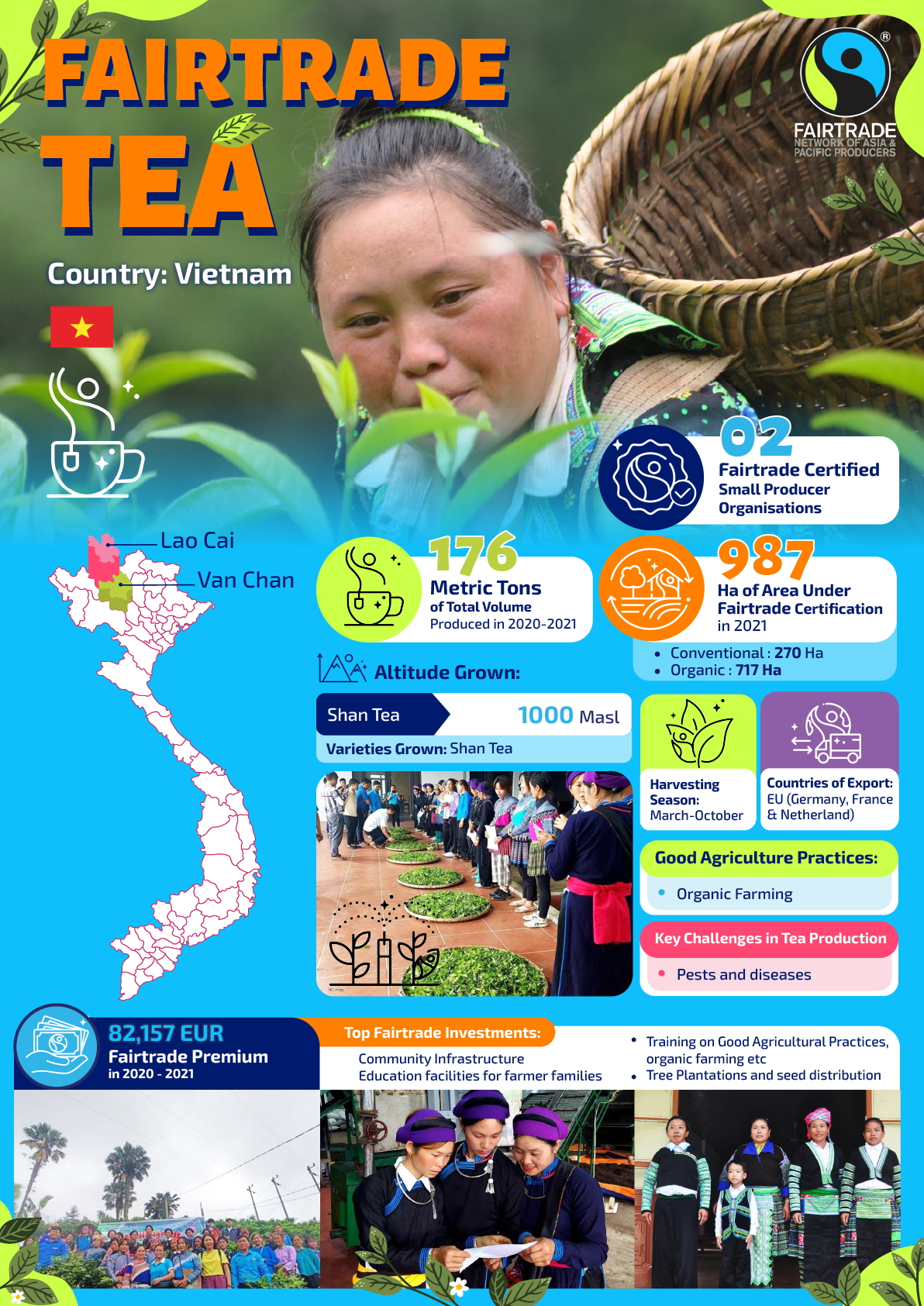
CHINA
Background of Tea in China
As the birthplace of tea production, China has a rich tea heritage and diverse tea regions that span over 5,000 years. The country is renowned for its wide variety of teas, including green tea, black tea, oolong tea, white tea, and pu-erh tea, each offering unique flavours, aromas, and health benefits. Several prominent tea-producing regions, such as Yunnan, Fujian, Zhejiang, and Anhui have their own distinct environmental conditions and tea production techniques that influence the characteristics and quality of the tea they produce.
Zhejiang Province, located in eastern China, is known for its green tea production. Notably, it is home to famous green teas like Longjing (Dragon Well) and Huoshan Huangya, Tea gardens of Zhejiang Province of Eastern China are typically found in mountainous areas with elevations ranging from 200 to 1200 meters above sea level. Situated in central China, the Hunan province produces various teas, including black tea, green tea, and scented tea in addition to the renowned yellow tea. Tea gardens in Hunan are also found in mountainous regions with elevations ranging from 100 to 1200 meters above sea level. Most Fairtrade-certified tea producers are located within this region.
Known for its high-quality green teas like Xinyang Maojian and Yichang Maojian, the Hubei Province is located in central China. The tea gardens in Hubei have elevations ranging from 200 to 1200 meters above sea level. Jiangxi Province, situated in southeastern China, produces green tea, black tea, and oolong tea. Notable teas from Jiangxi include Lushan Yunwu and Wuyuan Black. Tea gardens in Jiangxi are found in mountainous regions with elevations ranging from 100 to 1800 meters above sea level.
Despite the variation in the tea production cycle, the harvest season begins in the spring with the first flush and continues through the summer and autumn. The timing of harvests is influenced by factors such as local climate, tea variety, and growing conditions. Some teas, like green tea, maybe harvested 1-3 times per year, while others, like white tea, are typically harvested once a year in the spring.
Despite being a smaller segment of China’s overall tea exports, Fairtrade-certified tea occupies an important market for Chinese tea producers who prioritize ethical and sustainable
production practices. It provides opportunities for small-scale tea farmers to engage in sustainable farming practices and gain access to ethical markets. It offers them a chance to build their communities and improve their livelihoods by receiving fair premiums for their tea. Today, China ranks as the 7th largest producer of Fairtrade-certified tea globally. In 2019, China produced 7,076 metric tons of Fairtrade-certified tea. Particularly known for being the largest producer of Fairtrade-certified green tea with 1,889 metric tons in 2019, the UK, the US, and Japan are significantly imported in varying quantities imported in recent years.
From the unique flavours of green tea to the robustness of black tea and the complexities of oolong and pu-erh teas, China’s tea regions offer a wealth of options for tea connoisseurs worldwide. With Fairtrade-certified tea production on the rise, Chinese tea producers have the opportunity to cater to the growing demand for sustainable and ethically produced teas while empowering small-scale farmers in the process. The Chinese tea heritage recounts a wealth of expert wisdom passed down through generations that enriches both the cultural fabric and the sense of national pride within the country.
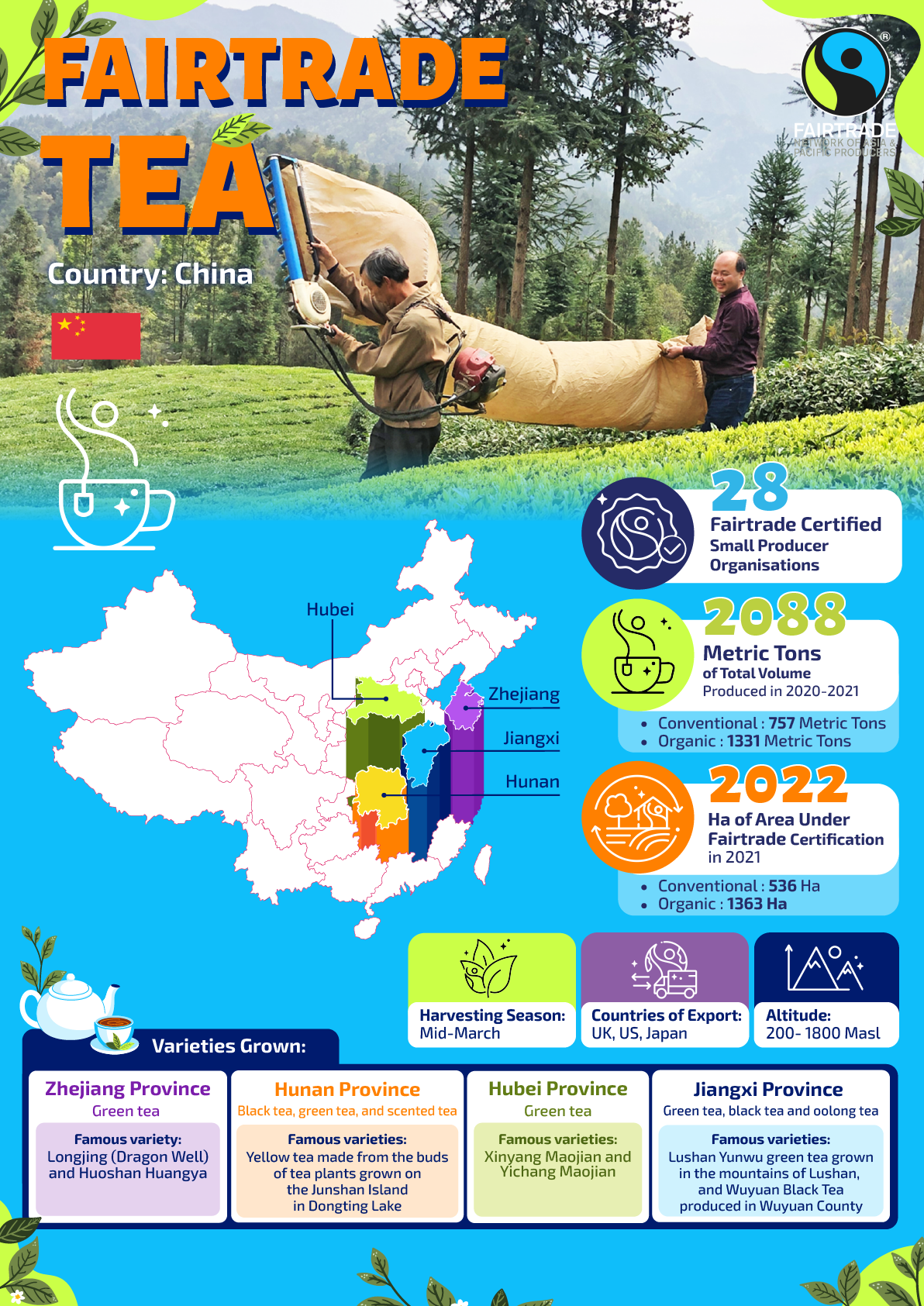
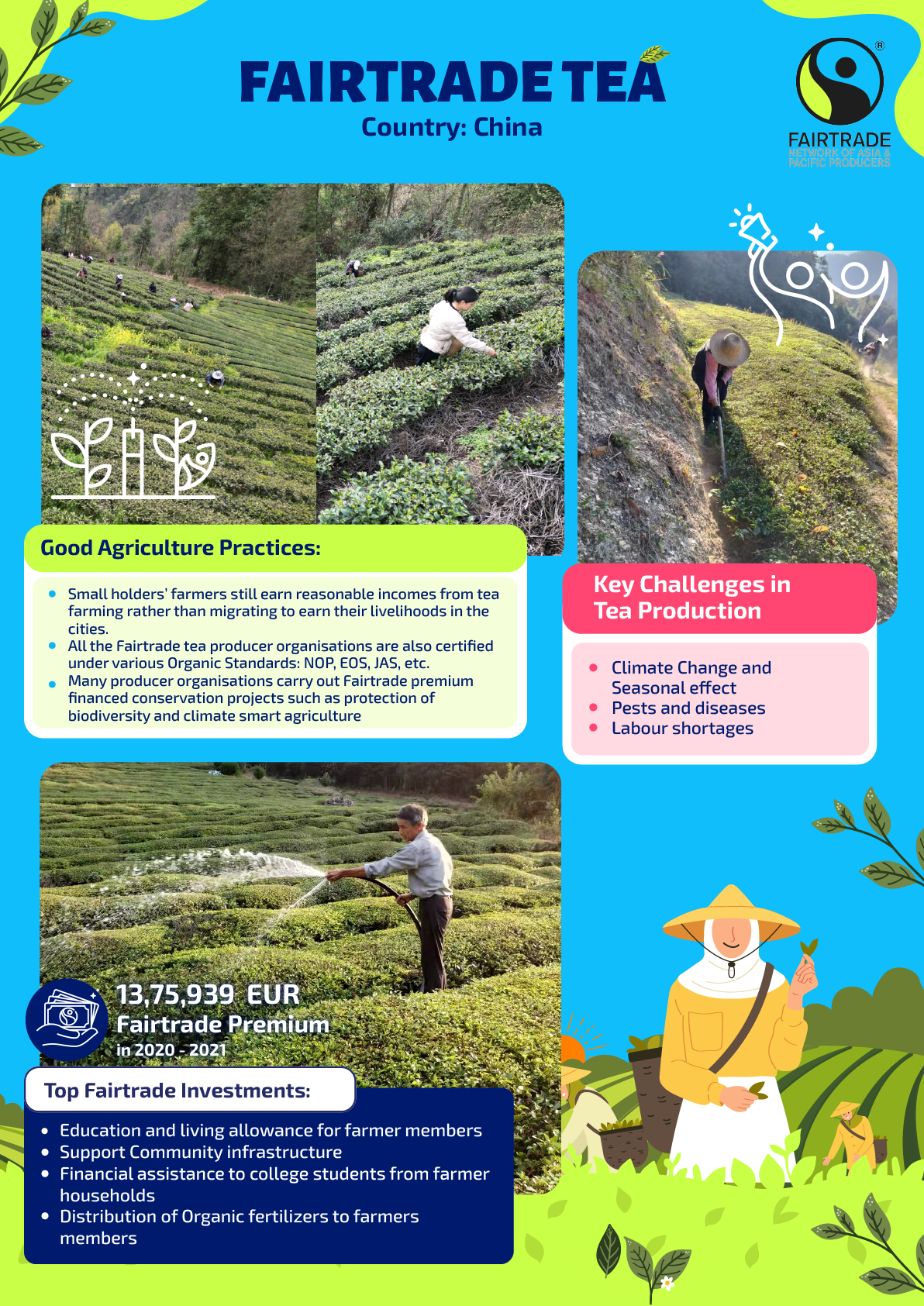
SRI LANKA
Background of Tea in Sri Lanka
From the island of Central Highlands, fertile landscape and spanning history, Sri Lanka has a captivating journey through the history of tea production in Sri Lanka. Set amidst the verdant embrace of rolling hills, the narrative unfolds with the emergence of Britishers who detected the untapped potential of this enchanting island. From modest beginnings as a commercial crop in the 19th century, tea rapidly grew to symbolize Sri Lanka’s prosperity and cultural heritage.
Formerly known as Ceylon, Sri Lanka’s favourable climate and diverse elevations enable the cultivation of both Camellia sinensis var. assamica and Camellia sinensis var. sinensis, with the assamica varietal dominating production. This led to a distinctive tea heritage that encompasses the artistry of green tea, white tea, and oolong tea. Today, Ceylon black tea has emerged as a source of national pride whose unique robust qualities have entranced tea enthusiasts worldwide.
Despite the variation in the tea production cycle, the harvest season begins in the spring with the first flush and continues through the summer and autumn. The timing of harvests is influenced by factors such as local climate, tea variety, and growing conditions. Some teas, like green tea, maybe harvested 1-3 times per year, while others, like white tea, are typically harvested once a year in the spring.
Despite being a smaller segment of China’s overall tea exports, Fairtrade-certified tea occupies an important market for Chinese tea producers who prioritize ethical and sustainable
production practices. It provides opportunities for small-scale tea farmers to engage in sustainable farming practices and gain access to ethical markets. It offers them a chance to build their communities and improve their livelihoods by receiving fair premiums for their tea. Today, China ranks as the 7th largest producer of Fairtrade-certified tea globally. In 2019, China produced 7,076 metric tons of Fairtrade-certified tea. Particularly known for being the largest producer of Fairtrade-certified green tea with 1,889 metric tons in 2019, the UK, the US, and Japan are significantly imported in varying quantities imported in recent years.
From the unique flavours of green tea to the robustness of black tea and the complexities of oolong and pu-erh teas, China’s tea regions offer a wealth of options for tea connoisseurs worldwide. With Fairtrade-certified tea production on the rise, Chinese tea producers have the opportunity to cater to the growing demand for sustainable and ethically produced teas while empowering small-scale farmers in the process. The Chinese tea heritage recounts a wealth of expert wisdom passed down through generations that enriches both the cultural fabric and the sense of national pride within the country.
